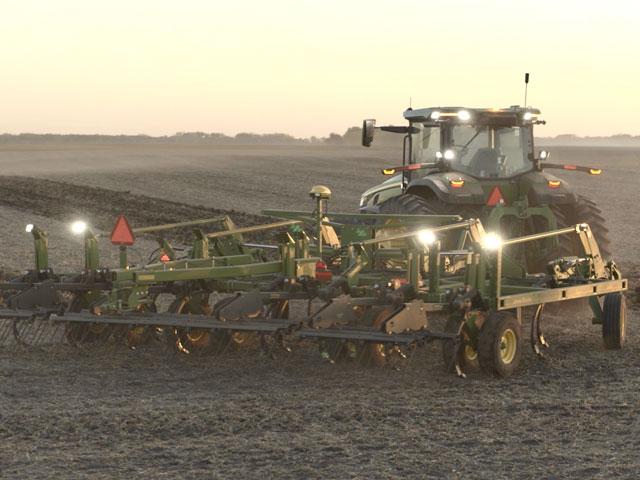Deere to Deliver Keynote at 2023 CES
Deere CEO Prepares to Tell CES How Ag Tech Will Sustainably Feed the World
LAS VEGAS (DTN) -- As John Deere CEO John May finalizes the keynote address he will present Thursday morning at the 2023 CES, it was the Consumer Technology Association's Steve Koenig who Wednesday morning cast a big net over the technologies that will be seen and discussed this week by the 180,000 attendees from 173 nations descending now on Las Vegas.
The CES is branded as the most influential tech event in the world. The Consumer Technology Association owns and produces the CES, once known as the Consumer Electronics Show.
Much of what Koenig described was a vision of industries solving problems with technologies driven by voice (otherwise called natural language processing, interactions between computers and humans), visualization, automation and much more. In effect, searching for ways to be more productive, more precise and targeted, and more sustainable, all while selling more services to consumers of all stripes -- think Starbucks ordered by voice from your car/truck/semi or buying services from a growing menu of options available when you buy a new car/truck/semi or a tractor/combine.
Koenig offered many interesting ideas, but only one about agriculture. Still, he laid out the bones, without a lot of meat perhaps, to what's coming. And, while much of what he said related to non-ag issues, it's not hard to see where many of these technologies will -- and already are -- find a home in agriculture.
Think technology or capabilities as a fee-for-service, visualization or voice-activated systems and commands. Visualization might be used to transform raw data into virtual representations of a space. Above ground? Sure. How about below ground at the seed level?
5G technology will enable it. The 5G technologies that will be rolled out in the next half-dozen or so years will bring deep levels of connected intelligence, automated/autonomous systems, quantum computing and more. 5G is the transmission pipe enabling far greater speed; it enables autonomous systems and has low latency, or the time it takes data to move from one network to another. There is no simple explanation for quantum computing, but it is the fuel behind emerging technologies in areas like artificial intelligence.
P[L1] D[0x0] M[300x250] OOP[F] ADUNIT[] T[]
Koenig mentioned CES exhibitor Deere in his address, showed a picture of its autonomous 8R tractor introduced here last year and pointed out to the assembled media that there was no "farmer" in that tractor. He said it was a robot.
But the absence of that farmer (or the arguable fact that the farmer-less tractor is just a robot) is not the real story. Much more is happening in the cab with and without a farmer and will be happening in that cab with or without an operator that will make Deere's tools and the production technologies offered by other manufacturers connected, productive (planting, harvesting, logistics) predictive, precise, targeted and sustainable.
That's the story Deere is expected to bring to the assembled tech world Thursday morning.
In a CES first, May's address as CEO of Deere marks the first time an ag technology company will take the main stage for a keynote at the CES. He is expected to share how purpose-driven sustainability and advancements in technology are helping to feed a growing population.
Deere has won a pair of 2023 CES innovation awards in advance of the public opening Thursday for Best of Innovation (Robotics), and Deere was an honoree in the Vehicle Tech and Advance Mobility Category.
Deere has been a major exhibitor here since 2019, bringing the technologies of combines, sprayers, planters, tractors (and the real-life "bigness" of farm equipment) to techies from around the world. As of this filing, by way of a note, Deere is not saying what its exhibit will hold this year.
Three other notes regarding technology and the human world:
-- COVID-era supply chain problems are easing, but remain worrisome. "It's true that container costs have come down, and we're seeing less friction at global ports," said Koenig. "But you have only really to look at what's going on in China at the moment (to) understand just how vulnerable supply chains remain."
-- Semiconductor demand is starting to soften. "But this is kind of a good news, bad news situation," Koenig said. "On the one hand, we're starting to see light at the end of the tunnel on the chip shortage, but we're also, in certain cases, potentially facing an oversupply. From shortage to oversupply, the downside risk is that we might see a deferral of some of the new chip architectures and processors.
-- And this "encouraging" nugget: The U.S. is 10 million workers shy of what it needs to fill demand. By 2023, America will be 160,000 semi drivers short. But over the course of those long COVID nights, a new Consumer Technology Association study shows that we've grown 9 million new gamers (ages 13-64) than it counted in 2019. That's for a U.S. total of 164 million gamers, on average playing games 24 hours per week (up from 16 hours in 2019).
Dan Miller can be reached at dan.miller@dtn.com
Follow him on Twitter @DMillerPF
(c) Copyright 2023 DTN, LLC. All rights reserved.



